Picture of the week
| Previous weeks |
 July
20, 2014 July
20, 2014 |
 July13,
2014 July13,
2014 |
 June
29, 2014 June
29, 2014 |
 June
15, 2014 June
15, 2014 |
|
|
 June
1, 2014 June
1, 2014 |
 May
25, 2014 May
25, 2014 |
 May
11, 2014 May
11, 2014 |
 Apr
27, 2014 Apr
27, 2014 |
 Apr
20, 2014 Apr
20, 2014 |
|
|
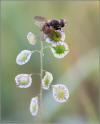 Apr
6, 2014 Apr
6, 2014 |
|
|
| Older |
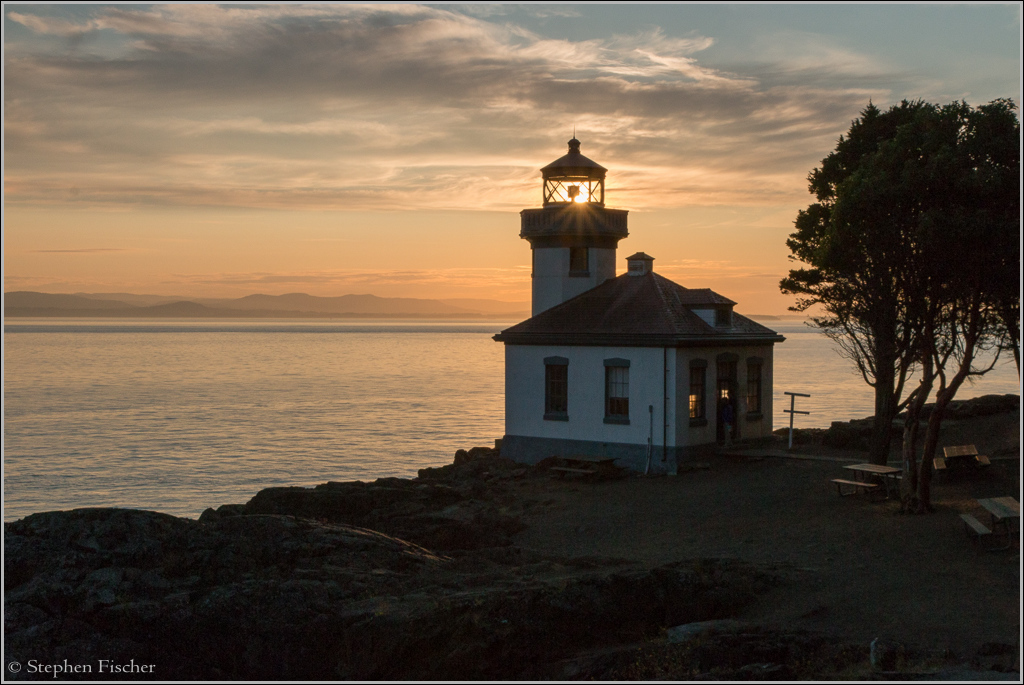
Lime Kiln Lighthouse
Captured this photograph with the sun setting through the lighthouse beacon. The Lime Kiln Lighthouse is located on the west side of San Juan Island, part of Washington, north of Puget Sound. Orca whales can often be seen from this point, but unfortunately I was not so lucky on this visit. Photo-ops here were limited to some landscape, harbor seals, and a few porpoises in the distance.
I visited this location with two other friends the night before a 5 day kayaking expedition around these islands. This trip was organized by the Alder Creek Kayak Company based in Portland. Through this trip via the two team leaders (Andrew and Steve) we learned the essential skills necessary for expedition style kayaking, being self sufficient, carrying our food, water and all necessary camping gear. We were also taught navigational skills, route planning factoring in the currents and weather, longer duration paddling skills, dealing with challenging weather and water conditions, including rescue techniques, and beach landing/launching techniques in the surf.
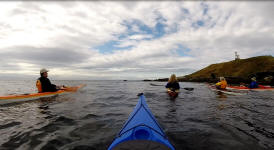 We
started the trip from Friday Harbor, camping the first night at Griffin Bay
near the southern end. After enduring a sustained rain the first night
and next morning, we then headed off in attempt to round Cattle Point and
head up on the more exposed southern side heading toward the northwest for a
15 mile slug up to the San Juan campground. Despite having a favorable
ebb tide to help up us the first half of this leg, we faced 15 to 25 knot
headwinds with 3 to 4 foot waves. After a couple of hours making
little progress up the coast around the point, we made an unplanned beach
landing through the surf to take a break, have lunch, and wait to see if the
conditions would calm down to make better progress. After relaunching
into the surf (which was quite an experience by itself), the
We
started the trip from Friday Harbor, camping the first night at Griffin Bay
near the southern end. After enduring a sustained rain the first night
and next morning, we then headed off in attempt to round Cattle Point and
head up on the more exposed southern side heading toward the northwest for a
15 mile slug up to the San Juan campground. Despite having a favorable
ebb tide to help up us the first half of this leg, we faced 15 to 25 knot
headwinds with 3 to 4 foot waves. After a couple of hours making
little progress up the coast around the point, we made an unplanned beach
landing through the surf to take a break, have lunch, and wait to see if the
conditions would calm down to make better progress. After relaunching
into the surf (which was quite an experience by itself), the team leader Andrew decided after about 30 minutes of more paddling that
hitting our planned destination that night would not be feasible with the
current weather conditions. We then aborted, turning around and
heading back to spend a second night at the Griffin Bay camp site after
fighting the wind and current most of the way back. This required
"hand-railing" closer to the shoreline in order to take advantage of eddy
currents for reducing the paddling effort and exposure from the wind.
By the time the group got back to camp around 5:30 pm, after leaving that
morning around 9am, we were all thoroughly exhausted. But at
least the weather had cleared, giving us a chance to dry out our camping gear
that we had more hastily packed wet that morning. We jokingly
reflected on which we preferred: calmer waters under rain, or windy drier
conditions. The choice was easy, taking rain anytime versus dealing
with the wind and rougher seas that come with it.
team leader Andrew decided after about 30 minutes of more paddling that
hitting our planned destination that night would not be feasible with the
current weather conditions. We then aborted, turning around and
heading back to spend a second night at the Griffin Bay camp site after
fighting the wind and current most of the way back. This required
"hand-railing" closer to the shoreline in order to take advantage of eddy
currents for reducing the paddling effort and exposure from the wind.
By the time the group got back to camp around 5:30 pm, after leaving that
morning around 9am, we were all thoroughly exhausted. But at
least the weather had cleared, giving us a chance to dry out our camping gear
that we had more hastily packed wet that morning. We jokingly
reflected on which we preferred: calmer waters under rain, or windy drier
conditions. The choice was easy, taking rain anytime versus dealing
with the wind and rougher seas that come with it.
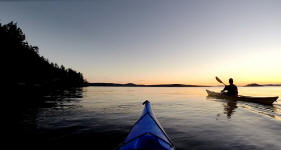 The
rest of the trip was easier with friendlier weather and more protected
waters. With the change in route plans, we headed north, camping in Indian
Cove on Shaw Island for the third night, and then at the southern end of
Jones Island for the fourth night. The last night on Jones Island was my
favorite, with a very pleasant camping area and a small protected cove in order to
practice self and assisted rescue techniques.
The
rest of the trip was easier with friendlier weather and more protected
waters. With the change in route plans, we headed north, camping in Indian
Cove on Shaw Island for the third night, and then at the southern end of
Jones Island for the fourth night. The last night on Jones Island was my
favorite, with a very pleasant camping area and a small protected cove in order to
practice self and assisted rescue techniques.
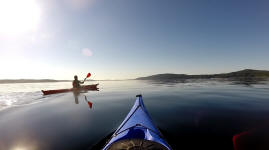 After dinner, some of us
also did a sunset paddle around the island, while a couple of the others
elected for
a walk to explore the island by foot. After the earlier grueling experience in
our attempt around Cattle Point, the sunset paddle around Jones Island was a
great way to cap the trip on a more peaceful note. With our boats unloaded from the camping
gear and food, our kayaks felt much more nimble and fast, allowing us to get
around the entire island in 40 minutes, while drafting and joking around with "pit
manuevers" on each others kayaks. After a relaxing sleep, on the fifth day
we headed back to Friday Harbor, via a relatively short and easy 5~6 mile
paddle, going with an ebb tide all the way back. We then packed up,
said our goodbyes, and still had time to catch the early afternoon ferry for
Anacortes after buying lunch and enjoying some beers with our two guides.
After dinner, some of us
also did a sunset paddle around the island, while a couple of the others
elected for
a walk to explore the island by foot. After the earlier grueling experience in
our attempt around Cattle Point, the sunset paddle around Jones Island was a
great way to cap the trip on a more peaceful note. With our boats unloaded from the camping
gear and food, our kayaks felt much more nimble and fast, allowing us to get
around the entire island in 40 minutes, while drafting and joking around with "pit
manuevers" on each others kayaks. After a relaxing sleep, on the fifth day
we headed back to Friday Harbor, via a relatively short and easy 5~6 mile
paddle, going with an ebb tide all the way back. We then packed up,
said our goodbyes, and still had time to catch the early afternoon ferry for
Anacortes after buying lunch and enjoying some beers with our two guides.
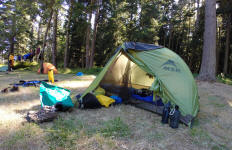 Looking
back at this trip, it was quite memorable and one that I am grateful to have
experienced. Despite the difficulties on the second day and having to
abort our target destination for that night, the experience and learning
from that effort and the rest of the trip will be unforgettable. I feel this
adventure has given me valuable experience and confidence in how to deal
with more adverse and unforeseen conditions that can pop-up during
expedition style kayaking travel. Andrew and Steve from
Alder Creek Kayak were
also terrific guides for this trip. Their experience, skills, and
friendliness made the trip both enjoyable and a productive learning
experience. Under their leadership, I did not really worry about the uncertainties
that can come with this type of travel. It turns out, we were the
pilot group for this trip from Alder Creek. And after talking about this
with the others, everyone believes it was a great success and one that will
be repeated more in the future. It was also helpful that everyone had a
positive can-do attitude and proficient in their paddling skills.
Looking
back at this trip, it was quite memorable and one that I am grateful to have
experienced. Despite the difficulties on the second day and having to
abort our target destination for that night, the experience and learning
from that effort and the rest of the trip will be unforgettable. I feel this
adventure has given me valuable experience and confidence in how to deal
with more adverse and unforeseen conditions that can pop-up during
expedition style kayaking travel. Andrew and Steve from
Alder Creek Kayak were
also terrific guides for this trip. Their experience, skills, and
friendliness made the trip both enjoyable and a productive learning
experience. Under their leadership, I did not really worry about the uncertainties
that can come with this type of travel. It turns out, we were the
pilot group for this trip from Alder Creek. And after talking about this
with the others, everyone believes it was a great success and one that will
be repeated more in the future. It was also helpful that everyone had a
positive can-do attitude and proficient in their paddling skills.
As far as photography was concerned, I packed my Canon 70D with the 100-400mm IS L f/4.5-5.6 telephoto lens in a dry bag, stowed in the rear hatch right behind me. My plan was to use it sparingly in case of some more photo worthy opportunities occured, such as a pod of orcas. But unfortunately, no such conditions presented themselves on this trip. Also given the skill level of the team and paddling requirements that came with this, pausing to pull this setup out would not be that practical without slowing down the pace and progress of the whole group.
My other form of documenting this trip was via a GoPro Hero 3+ Silver edition camera mounted on the deck of my boat, far enough in front to not interfere with my paddling. I used an 8" articulating arm in order to provide a bit more clearance such that the image would not be too dominated by the front hull of the boat. This worked out okay, but the adhesive for the GoPro mount to the deck came loose during the stormy conditions on the second day. This was resolved with some "Shoe Goo" adhesive from Andrew that does a much better job, keeping the camera mount intact for the rest of the trip. The biggest challenge for the GoPro is stretching the battery life by sparingly use of the camera. I brought 3 fully charged batteries, but each only lasts for about 30-40 minutes worth of video capture at 1080p and 60fps. By the end, I had filled up a 32G micro-SD card and while burning through most of the third battery. The images shown above are either frame captures off these video sequences, or still shots while hand holding the GoPro on land. In the near future I plan on posting an edited video sequence of this trip based on this footage.
All content and images are property of Stephen Fischer Photography, copyright 2014. Last updated: 8/4/2014 ()